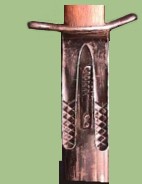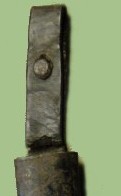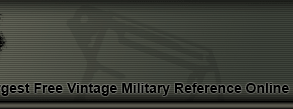The history of the WWII German Fighting Knife Dagger -
The Third Reich issued a large number of edge weapons to the military and civilian organizations. somne of these blades were meant for combat while others were simply a status symbol. The high quality of construction and beautiful designs make these items desirable military collectibles. One of the interesting variations found was the fighting knife.

The fighting knife, also known as the boot knife, was first introduced during WWI. Trench warfare required the need to
have a close quarters weapon in case that enemy troops infiltrated the lines. The trenches were not extremely wide.
There was not alot of room to have large body movements. Hence the introduction of the fighting knife.
FIGHTING KNIFE ANATOMY
The German fighting knife, also known as the boot knife, was born in the trenches of WWI. but its use was extended through WWII. While the general shape remained intact, a few different variations were created. Changes primarily involved the grip where somtimes it has a checkered pattern carved into its surface. The German fighting knife was small in size because the idea was to be able to carry it on the side of the boot.
Consisting of a wooden handle. Smooth construction and light brown color. The pommel section has a small wooden protrution. The crossguard was very simple. It was formed by a thin piece of metal with one side angling up a few degrees. The other side remained straight. In other cases the crossguard was almost non-existant. there was simply a thicker piece of metal that
was barely bigger in width than the rest of the knife.
THE SCABBARD
The scabbard was originally painted black but through time most of the paint has worn off showing the metal finish. Notice that the same type of rivets are employed in the scabbard as those used to attach the grips to the tang.
 |
The scabbard was normally equipped with a large clip that allowed the knife to be carried on the belt or in a boot.
Its design was formed of three elongated shape fingers. With the middle section being slightly lower than the rest. A checkered pattern is engraved in about 50% of each finger as it approaches the tip for the outer sections and closer to the base for the middle component. This feature was intended to provide added traction so the knife would not fall from the surface where it was holding to.
However, some scabbards did not have this feature. They were equipped with a leather loopbelt that was riveted to the
back section or they were equipped with a leather frog to attach to the belt.
|
 |
| WWII GERMAN FIGHTING KNIFE EXAMPLES |
The more examples of a particular dagger that are examined the more knowledge is gained about the particular piece.
Differences in construction can be better appreciated. Markings on the blade and other sections are better understood.
The overall knowledge about the dagger is expanded.
This section of the site provides several examples of the fighting knives.
| WWII GERMAN FIGHTING KNIFE MARKINGS |
Several of the German fighting knives were not marked. However, there were some that were stamped
with the manufacturer's name or with other markings.
The following is a list of some of the companies that manufactured the fighting knives during WWII.
It is important to note that this may not be a complete list as it is possible that others manufacturers
exist.
| Count |
Unique Makers |
Company |
Description |
Logo |
Comments |
| 1 |
1 |
Puma |
 |
The word PUMA is spelled out. 1a Gusstahl placed above. |
Solingen |
| 2 |
2 |
Union |
 |
The word UNION is spelled out. Just below is Zell St.Bt. |
n/a |
| 3 |
3 |
Unknown |
 |
Short pyramid structure with number 5 or letter S inside. |
n/a |
| 4 |
4 |
|
n/a |
n/a |
n/a |
This information is brought to you courtesy of
MilitaryItems.com.
The premiere provider of military collectibles to musuems, educational institutions and
the general enthusiast.
|







